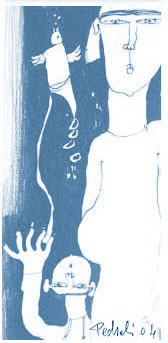HOT TOPICS dalla letteratura internazionale
| HOT TOPICS dalla letteratura internazionale a cura di Alberto M. Luciano The Culture of Zygotes to the Blastocyst Stage Changes the Postnatal Expression of an Epigentically Labile Allele, Agouti Viable Yellow, in Mice1 Hugh D. Morgan, Xing L. Jin, Aiqing Li, Emma Whitelaw, and Chris O’Neill Biology of Reproduction 79, 618–623 (2008) Published online before print 18 June 2008. DOI 10.1095/biolreprod.108.068213 |
|
Restricting the growth of the embryo can cause adverse whole-of-life changes in an organism’s omeostasis. Such adverse long-term consequences may occur even when growth restriction occurs only during the preimplantation period. The molecular basis for these long-term effects has not been defined, although an epigenetic mechanism is suspected. Some loci seem to be more sensitive to epigenetic perturbation than others, and the agouti viable yellow allele (Avy) is the best studied example of this. It has active (hypomethylated) and inactive (hypermethylated) epialleles. This study used the Avy model to show that growth restriction of preimplantation embryos, as provided by culture of zygotes, induced persistent epigenetic changes that resulted in altered postnatal phenotype. C57BL/6 Avy/a males were mated to ovulation-induced FVB/N females, and then either zygotes were collected and cultured for 96 h and the
Maternal and zygotic Dnmt1 are necessary and sufficient for the maintenance of DNA methylation imprints during preimplantation development Parental origin-specific DNA methylation regulates the monoallelic expression of the mammalian imprinted genes. The methylation marks or imprints are established in the parental germline and maintained throughout embryonic development. However, it is unclear how the methylation imprints are maintained through extensive demethylation in cleavage-stage preimplantation embryos. Previous reports suggested that DNA methyltransferase(s) other than Dnmt1 is involved in the maintenance of the imprints during cleavage. Here we demonstrate, by using conditional knockout mice, that the other known DNA methyltransferases Dnmt3a and Dnmt3b are dispensable for the maintenance of the methylation marks at most imprinted loci. We further demonstrate that a lack of both maternal and zygotic Dnmt1 results in complete demethylation of all imprinted loci examined in blastocysts. Consistent with these results we find that zygotic Dnmt1 is expressed in the preimplantation embryo. Thus, contrary to the previous reports, Dnmt1 alone is sufficient to maintain the methylation marks of the imprinted genes. The Maternal Nucleolus Is Essential for Early Embryonic Development With fertilization, the paternal and maternal contributions to the zygote are not equal. The oocyte and spermatozoon are equipped with complementary arsenals of cellular structures and molecules necessary for the creation of a developmentally competent embryo. We show that the nucleolus is exclusively of maternal origin. The maternal nucleolus is not necessary for oocyte maturation; however, it is necessary for the formation of pronuclear nucleoli after fertilization or parthenogenetic activation and is essential for further embryonic development. In addition, the nucleolus in the embryo produced by somatic cell nuclear transfer originates from the oocyte, demonstrating that the maternal nucleolus supports successful embryonic development.
Paracrine factors from cumulus-enclosed oocytes ensure the successful maturation and fertilization in vitro of denuded oocytes in the cat model Objective: To better characterize cumulus-oocyte interactions during oocyte maturation and fertilization in the cat model. Design: Experimental in vitro study. Setting: Smithsonian Institution. Animal(s): Domestic shorthair cats. Intervention(s): Groups of denuded oocytes (DOs) and cumulus-oocyte complexes (COCs) were subjected to
|
|

